Application of the Nitrogen Nutrition Index to Estimate the Yield of Indica Hybrid Rice Grown from Machine-Transplanted Bowl Seedlings
Abstract
:1. Introduction
2. Materials and Methods
2.1. Plant Materials and Experimental Details
2.2. Soil Sample Collection and Laboratory Analysis
2.3. Experimental Design and Treatments
2.4. Determination Content and Methods
2.4.1. Dry Matter (DM), Leaf Area Index (LAI), and Nitrogen Concentration
2.4.2. The Yield and Its Components
2.5. Data Analysis
2.5.1. Nc Model Based on DM
2.5.2. Nc Model Based on the LAI
2.5.3. Verification of the Nc Curve
2.5.4. Nitrogen Nutrition Index (NNI)
2.6. Statistical Analysis
3. Results
3.1. The Nc of Indica Hybrid Rice Grown from Machine-Transplanted Bowl Seedlings Based on the LAI
3.1.1. Dynamic Changes in the Agronomic Parameters in Different Growth Periods
3.1.2. Nc Based on the LAI
3.1.3. Model Validation and Comparison
3.2. Dynamic Changes in the NNI in the Indica Hybrid Rice Grown from Machine-Transplanted Bowl Seedlings
3.3. Relationship between the NNILAI and the Yield of Indica Hybrid Rice Grown from Machine-Transplanted Bowl Seedlings
3.3.1. Correlation between the NNILAI and Relative Yield (RY)
3.3.2. Relationship between the Yield and the Yield Components
3.3.3. Correlation between the NNILAI and the Relative Yield Components
4. Discussion
4.1. Comparison of the Different Nc Models
4.2. Comparison of Two Different NNIs (NNILAI and NNIDM)
4.3. Correlation between Two Different NNIs (NNILAI and NNIDM) and the Relative Yield and Relative Yield Components
5. Conclusions
Supplementary Materials
Author Contributions
Funding
Institutional Review Board Statement
Informed Consent Statement
Data Availability Statement
Conflicts of Interest
Abbreviations
| NNI | nitrogen nutrition index |
| NC | critical nitrogen concentration |
| NNILAI | nitrogen nutrition index calculated based on dry matter critical nitrogen concentration model |
| NNIDM | nitrogen nutrition index calculated based on leaf area index critical nitrogen concentration model |
| HLY 898 | Huiliangyou 898 |
| YLY 900 | Yliangyou 900 |
| RY | relative yield |
| LAI | leaf area index |
| Nt | the actual rice nitrogen concentration |
| Nmax | the maximum nitrogen concentration |
| Nmin | the minimum nitrogen concentration |
References
- National Bureau of Statististics of China. China National Statististics Year Book in 2021; National Statististics Press: Beijing, China, 2021. [Google Scholar]
- Spiertz, H. Challenges for Crop Production Research in Improving Land Use, Productivity and Sustainability. Sustainability 2013, 5, 1632–1644. [Google Scholar] [CrossRef] [Green Version]
- Chen, X.P.; Cui, Z.L.; Fan, M.S.; Vitousek, P.; Zhao, M.; Ma, W.Q.; Wang, Z.L.; Zhang, W.J.; Yan, X.Y.; Yang, J.C.; et al. Producing more grain with lower environmental costs. Nature 2014, 514, 486–489. [Google Scholar] [CrossRef]
- Pan, S.G.; Huang, S.Q.; Zhang, F.; Wang, J.P.; Cai, M.L.; Cao, C.G.; Tang, X.R.; Li, G.X. Growth and Development Characteristics of Super-High-Yielding Mid-Season Indica Hybrid Rice. Acta Agron. Sin. 2011, 37, 537–544. [Google Scholar] [CrossRef]
- Zhang, H.C.; Zhu, C.C.; Huo, Z.Y.; Xu, K.; Jiang, X.P.; Chen, H.C.; Gao, S.Q.; Li, D.J.; Zhao, C.M.; Dai, Q.; et al. Advantages of yield formation and main characteristics of physiological and ecological in rice with bowl mechanical transplanting. Trans. Chin. Soc. Agric. Eng. 2013, 29, 50–59. (In Chinese) [Google Scholar]
- Xu, X.; He, P.; Pampolino, M.F.; Qiu, S.; Zhao, S.; Zhou, W. Spatial variation of yield response and fertilizer requirements on regional scale for irrigated rice in China. Sci. Rep. 2019, 9, 3589. [Google Scholar] [CrossRef] [Green Version]
- Bentje, B.; Bjerg, P.L.; Song, X.F.; Jakobsen, R. Field scale interaction and nutrient exchange between surface water and shallow groundwater in the Baiyang Lake region, North China Plain. J. Environ. Sci. 2016, 45, 60–75. [Google Scholar]
- Guo, B.B.; Zhao, X.H.; Meng, Y.; Liu, M.R.; Duan, J.Z.; He, L.; Jiao, N.Y.; Feng, W.; Zhu, Y.J. Establishment of Critical Nitrogen Concentration Models in Winter Wheat under Different Irrigation Levels. Agronomy 2020, 10, 556. [Google Scholar] [CrossRef]
- Ata-Ul-Karim, S.T.; Zhu, Y.; Liu, X.; Cao, Q.; Tian, Y.; Cao, W. Comparison of different critical nitrogen dilution curves for nitrogen diagnosis in rice. Sci. Rep. 2017, 7, 42679. [Google Scholar] [CrossRef] [Green Version]
- Confalonieri, R.; Debellini, C.; Pirondini, M.; Possenti, P.; Bergamini, L.; Barlassina, G.; Bartoli, A.; Agostoni, E.G.; Appiani, M.; Babazadeh, L.; et al. A new approach for determining rice critical nitrogen concentration. J. Agric. Sci. 2011, 149, 5. [Google Scholar] [CrossRef]
- Zhao, B.; Ata-Ui-Karim, S.T.; Yao, X.; Tian, Y.C.; Cao, W.X.; Zhu, Y.; Liu, X.J. A New Curve of Critical Nitrogen Concentration Based on Spike Dry Matter for Winter Wheat in Eastern China. PLoS ONE 2016, 11, e0164545. [Google Scholar] [CrossRef]
- Yao, B.; He, H.B.; Xu, H.C.; Zhu, T.Z.; Liu, T.; Ke, J.; You, C.C.; Zhu, D.Q.; Wu, L.Q. Determining nitrogen status and quantifying nitrogen fertilizer requirement using a critical nitrogen dilution curve for hybrid Indica rice under mechanical pot-seedling transplanting pattern. J. Integr. Agric. 2021, 20, 1474–1486. [Google Scholar] [CrossRef]
- Ata-Ul-Karim, S.T.; Yao, X.; Liu, X.J.; Cao, W.X.; Zhu, Y. Development of critical nitrogen dilution curve of Japonica rice in Yangtze River Reaches. Field Crops Res. 2013, 149, 149–158. [Google Scholar] [CrossRef]
- Qiang, S.; Zhang, F.; Dyck, M.; Zhang, Y.; Xiang, Y.; Fan, J. Determination of critical nitrogen dilution curve based on leaf area index for winter wheat in the Guanzhong Plain, Northwest China. J. Integr. Agric. 2019, 18, 10. [Google Scholar] [CrossRef]
- Ata-Ul-Karim, S.T.; Zhu, Y.; Yao, X.; Cao, W.X. Determination of critical nitrogen dilution curve based on leaf area index in rice. Field Crops Res. 2014, 167, 76–85. [Google Scholar] [CrossRef]
- Zhao, B.; Ata-Ul-Karim, S.T.; Liu, Z.D.; Ning, D.F.; Xiao, J.F.; Liu, Z.G.; Qin, A.Z.; Nan, J.Q.; Duan, A.W. Development of a critical nitrogen dilution curve based on leaf dry matter for summer maize. Field Crops Res. 2017, 208, 60–68. [Google Scholar] [CrossRef]
- Sedlář, O.; Balík, J.; Černý, J.; Kulhánek, M.; Vašák, F. Relation between nitrogen nutrition index and production of spring malting barley. Int. J. Plant Prod. 2017, 11, 379–388. [Google Scholar]
- Du, L.; Li, Q.; Li, L.; Wu, Y.; Zhou, F.; Liu, B.; Li, X.; Liu, Q.; Kong, F.; Yuan, J. Construction of a critical nitrogen dilution curve for maize in Southwest China. Sci. Rep. 2020, 10, 13084. [Google Scholar] [CrossRef]
- Xu, H.C.; Yao, B.; Wang, Q.; Chen, T.T.; Zhu, T.Z.; He, H.B.; Ke, J.; You, C.C.; Wu, X.W.; Guo, S.S.; et al. Determination of suitable band width for estimating rice nitrogen nutrition index based on leaf reflectance spectra. Sci. Agric. Sin. 2021, 54, 4525–4539. (In Chinese) [Google Scholar]
- Kim, N.; Behnke, G.D.; Villamil, M.B. Characterization of Mollisols after Long-Term N Fertilization at Successive Rates in Continuous and Rotated Corn Systems. Agronomy 2022, 12, 625. [Google Scholar] [CrossRef]
- Tseng, W.Y.; Lai, H.Y. Comprehensive Analysis Revealed the Specific Soil Properties and Foliar Elements Respond to the Quality Composition Levels of Tea (Camellia sinensis L.). Agronomy 2022, 12, 670. [Google Scholar] [CrossRef]
- Wojewódzki, P.; Lemanowicz, J.; Debska, B.; Haddad, S.A. Soil Enzyme Activity Response under the Amendment of Different Types of Biochar. Agronomy 2022, 12, 569. [Google Scholar] [CrossRef]
- Lu, Q.; Miles, C.; Tao, H.; DeVetter, L.W. Reduced Nitrogen Fertilizer Rates Maintained Raspberry Growth in an Established Field. Agronomy 2022, 12, 672. [Google Scholar] [CrossRef]
- Zhao, B.; Yao, X.; Tian, Y.C.; Liu, X.J.; Cao, W.X.; Zhu, Y. Estimation of nitrogen nutrient index on SPAD value of top leaves in wheat. Acta Ecol. Sin. 2013, 33, 916–924. (In Chinese) [Google Scholar] [CrossRef] [Green Version]
- Wickham, H. Ggplot2; Springer: New York, NY, USA, 2009. [Google Scholar]
- Zhao, B.; Yao, X.; Tian, Y.C.; Liu, X.J.; Cao, W.X.; Zhu, Y. Accumulative nitrogen deficit models of wheat aboveground part based on critical nitrogen concentration. Chin. J. Appl. Ecol. 2012, 23, 3141–3148. (In Chinese) [Google Scholar]
- Guo, X.; Li, G.; Ding, X.; Zhang, J.; Ren, B.; Liu, P.; Zhang, S.; Zhao, B. Response of Leaf Senescence, Photosynthetic Characteristics, and Yield of Summer Maize to Controlled-Release Urea-Based Application Depth. Agronomy 2022, 12, 687. [Google Scholar] [CrossRef]
- Pang, C.; Zhang, W.; Peng, M.; Zhao, X.; Shi, R.; Wu, X.; Chen, F.; Sun, C.; Wang, X.; Zhang, J. Fine Mapping and Characterization of a Major Gene Responsible for Chlorophyll Biosynthesis in Brassica napus L. Biomolecules 2022, 12, 402. [Google Scholar] [CrossRef]
- Ma, L.; Wang, S.; Chen, J.; Chen, B.; Zhang, L.; Ma, L.; Amir, M.; Sun, L.; Zhou, G.; Meng, Z. Relationship between Light Use Efficiency and Photochemical Reflectance Index Corrected Using a BRDF Model at a Subtropical Mixed Forest. Remote Sens. 2020, 12, 550. [Google Scholar] [CrossRef] [Green Version]
- Song, L.; Wang, S.; Ye, W. Establishment and Application of Critical Nitrogen Dilution Curve for Rice Based on Leaf Dry Matter. Agronomy 2020, 10, 367. [Google Scholar] [CrossRef] [Green Version]
- Zhou, W.; Wang, T.; Fu, Y.; Yang, Z.P.; Liu, Q.; Yan, F.J.; Chen, Y.; Tao, Y.F.; Ren, W.J. Differences in Rice Productivity and Growth Attributes Under Different Paddy-Upland Cropping Systems. Int. J. Plant Prod. 2022, 1–14. [Google Scholar] [CrossRef]
- Wu, L.L.; Yuan, S.; Huang, L.Y.; Sun, F.; Zhu, G.L.; Li, G.H.; Fahad, S.; Peng, S.B.; Wang, F. Physiological Mechanisms Underlying the High-Grain Yield and High-Nitrogen Use Efficiency of Elite Rice Varieties under a Low Rate of Nitrogen Application in China. Front. Plant Sci. 2016, 7, 1024. [Google Scholar] [CrossRef] [Green Version]
- Sun, Y.J.; Ma, J.; Sun, Y.Y.; Xu, H.; Yang, Z.Y.; Liu, S.J.; Jia, X.W.; Zheng, H.Z. The effects of different water and nitrogen managements on yield and nitrogen use efficiency in hybrid rice of China. Field Crops Res. 2012, 127, 85–98. [Google Scholar] [CrossRef]
- Zhen, L.; Zoebisch, M.A.; Chen, G.; Feng, Z. Sustainability of farmers’ soil fertility management practices: A case study in the North China Plain. J. Environ. Manag. 2006, 79, 409–419. [Google Scholar] [CrossRef] [PubMed]
- Ma, P.; Lan, Y.; Lyu, T.; Zhang, Y.; Lin, D.; Li, F.; Li, Y.; Yang, Z.; Sun, Y.; Ma, J. Improving Rice Yields and Nitrogen Use Efficiency by Optimizing Nitrogen Management and Applications to Rapeseed in Rapeseed-Rice Rotation System. Agronomy 2020, 10, 1060. [Google Scholar] [CrossRef]
- Lemaire, G.; Jeuffroy, M.H.; Gastal, F. Diagnosis tool for plant and crop N status in vegetative stage: Theory and practices for crop N management. Eur. J. Agron. 2008, 28, 614–624. [Google Scholar] [CrossRef]
- Concenço, G.; Barbat, P.J.M.; Santos, M.I.; Valle, B.M.; Trombetta, D.S.J.; Emerim, C.S. Rice Yield Components under Water Stress Imposed at Different Growth Stages. J. Agric. Sci. 2018, 10, 3. [Google Scholar] [CrossRef] [Green Version]
- Nemoto, M.; Hamasaki, H.; Matsuba, S.; Hayashi, S.; Yanagihara, S. Estimation of Rice Yield Components with Meteorological Elements Divided According to Developmental Stages. J. Agric. Meteorol. 2016, 72, 3–4. [Google Scholar] [CrossRef] [Green Version]
- Benoit, C.; Crisanta, B.; Abigail, J.D.; Heathel, L.L.; Leigh, V. Leaf emergence, tillering, plant growth, and yield in response to plant density in a high-yielding aerobic rice crop. Field Crops Res. 2016, 199, 52–64. [Google Scholar]
- Awan, T.H.; Sta.Cruz, P.C.; Farooq, M.; Chauhan, S.B. Influence of Seeding Rate, Nitrogen Rate and Weed Regimes on Productivity and Nitrogen Efficiency of Dry Direct-Seeded Rice. Int. J. Plant Prod. 2021, 1–18. [Google Scholar] [CrossRef]
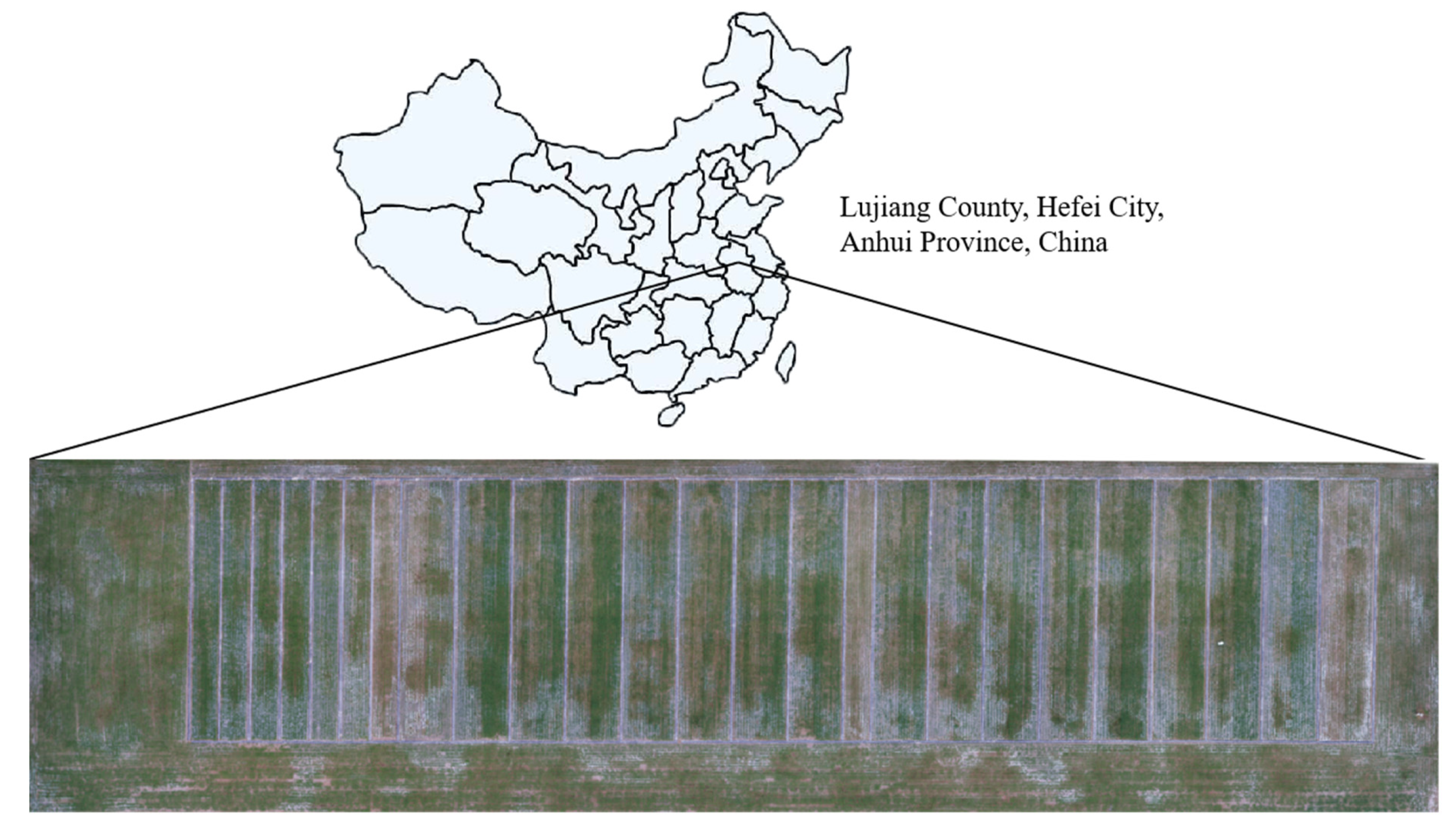

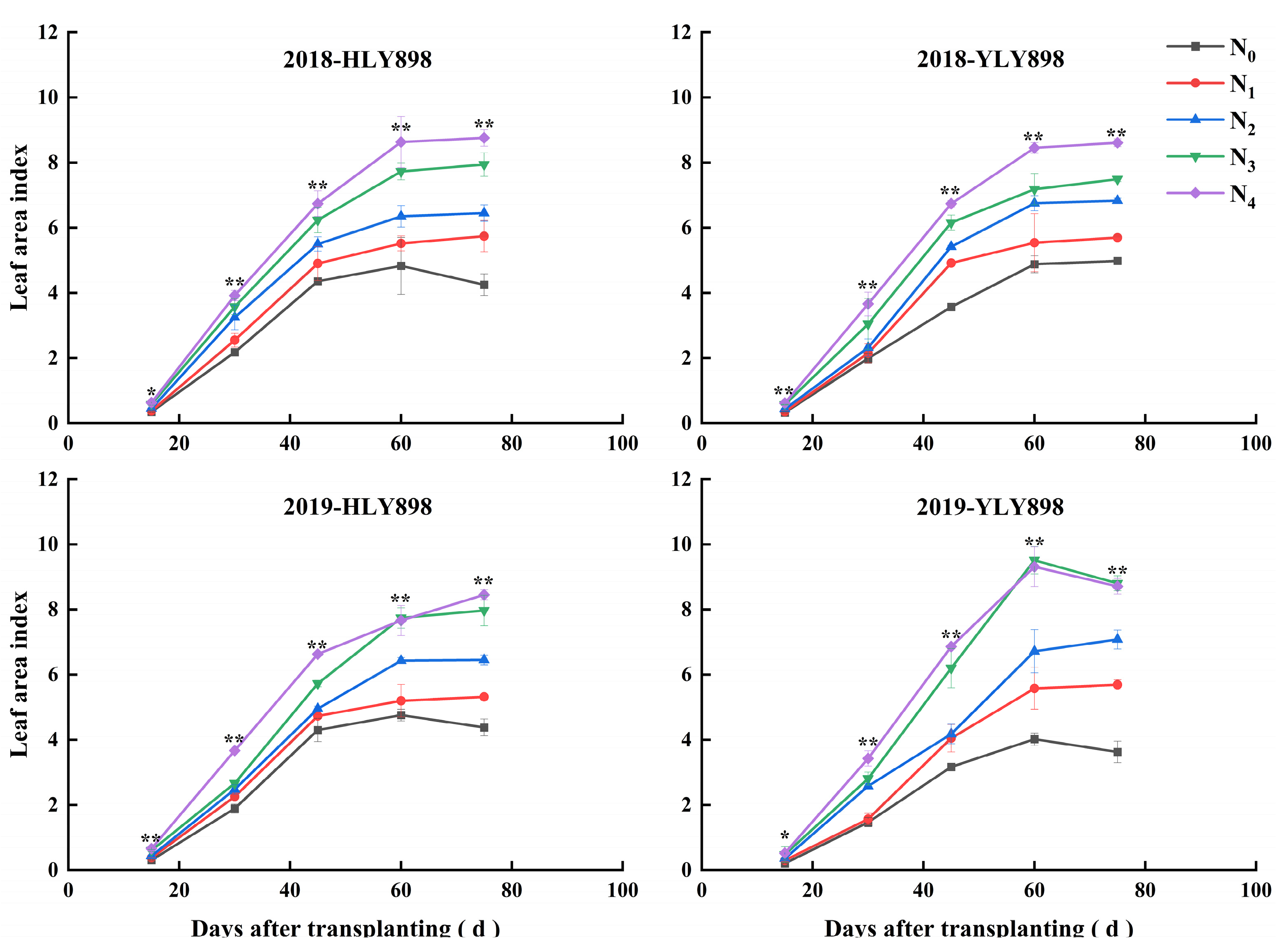
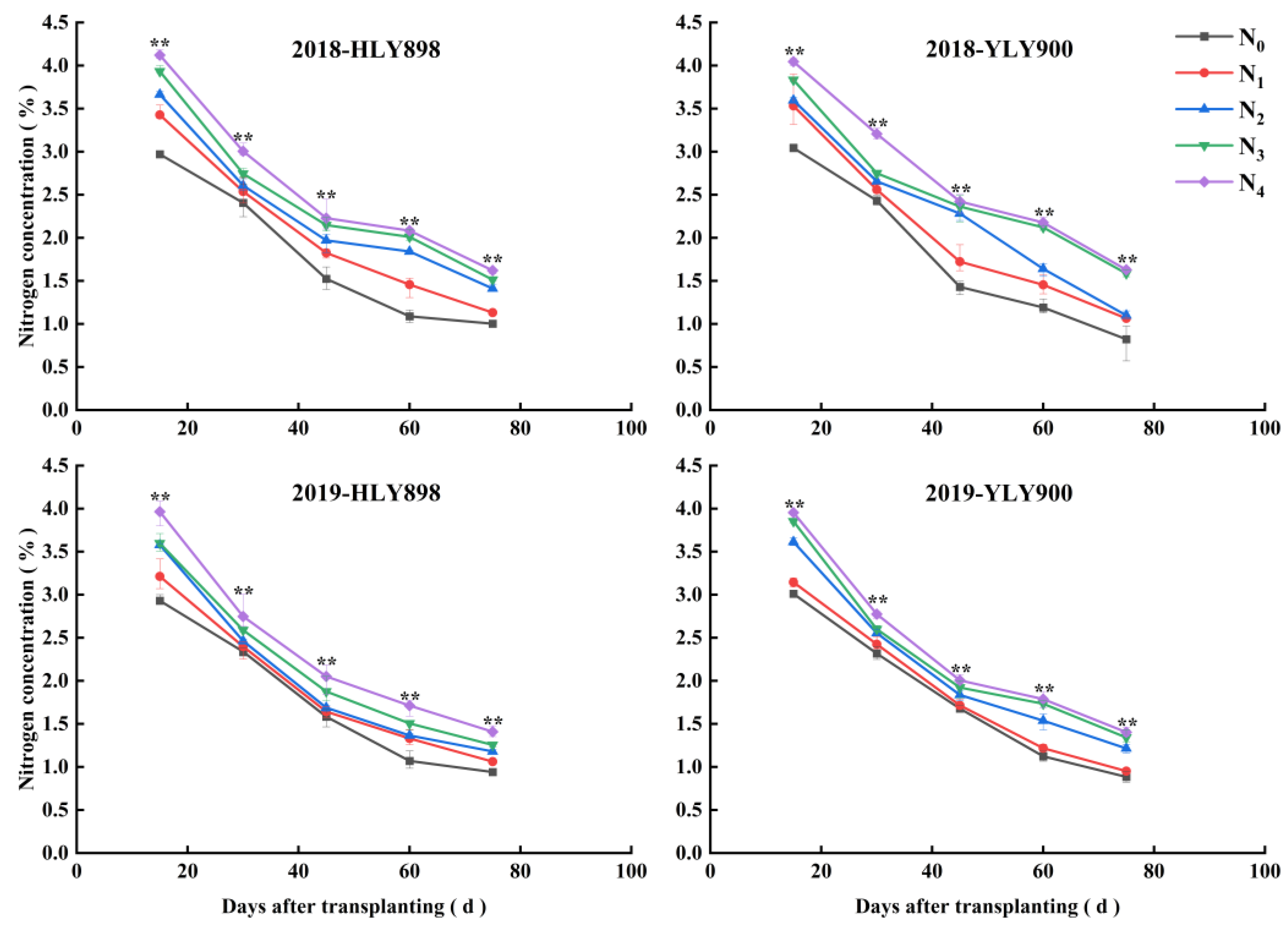

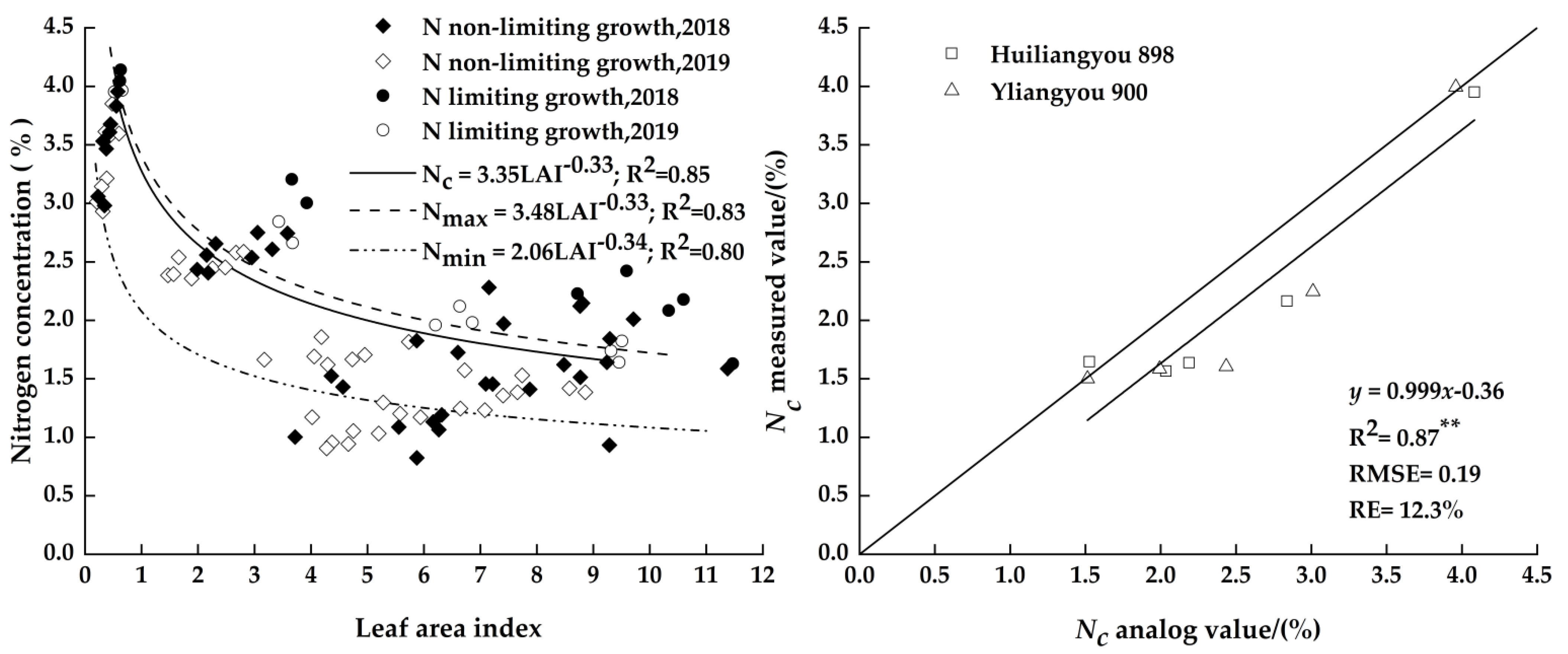
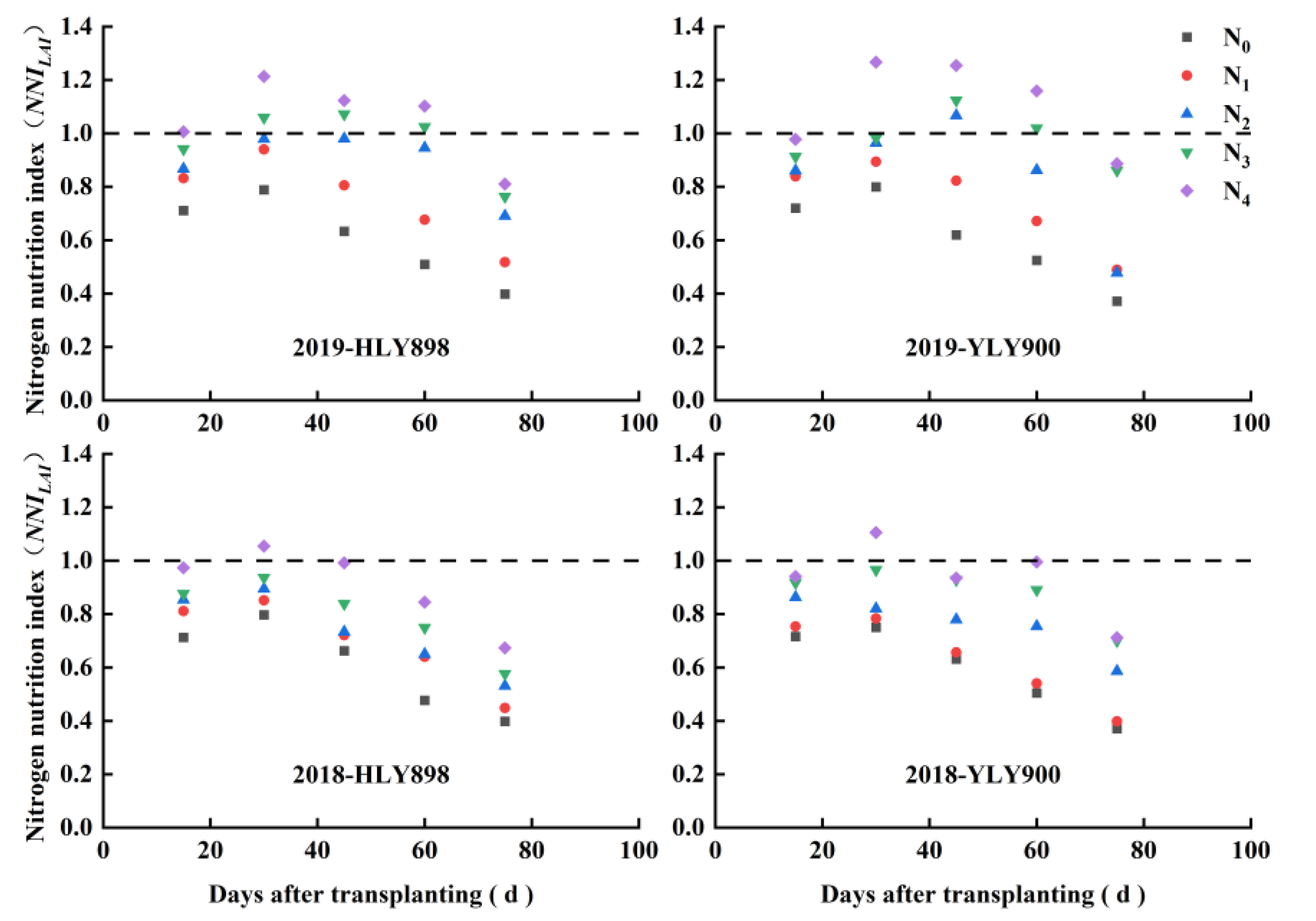
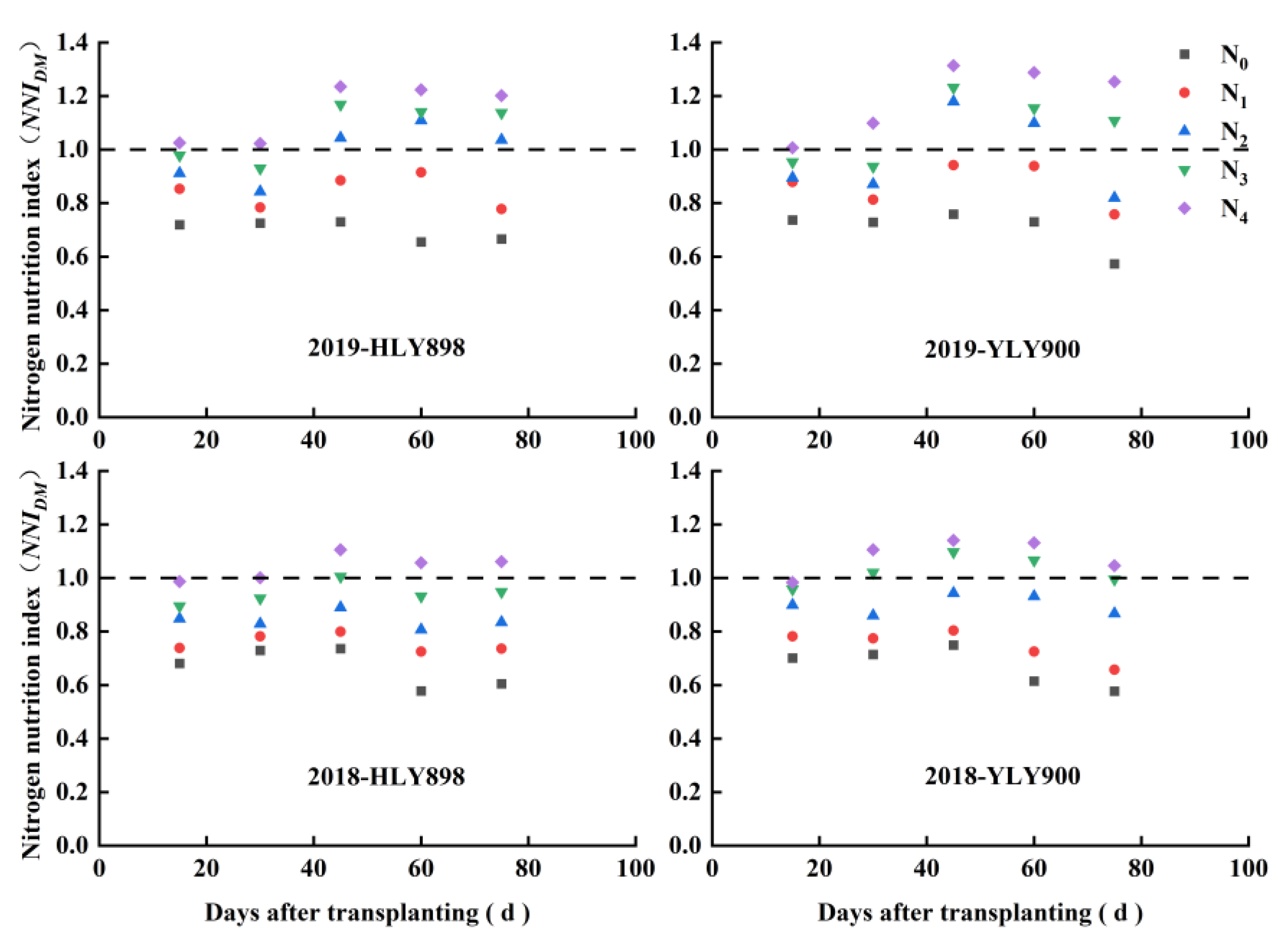
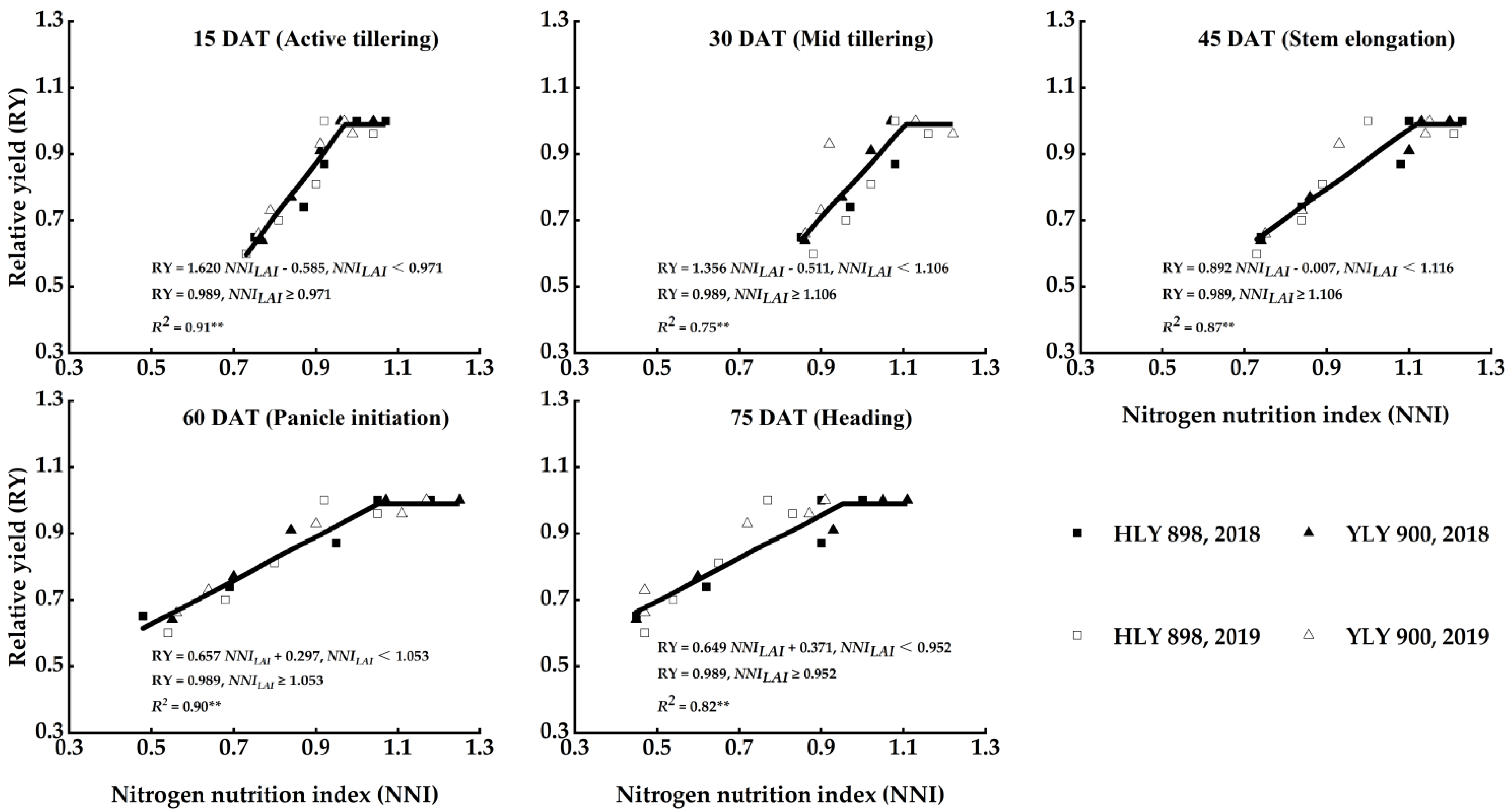
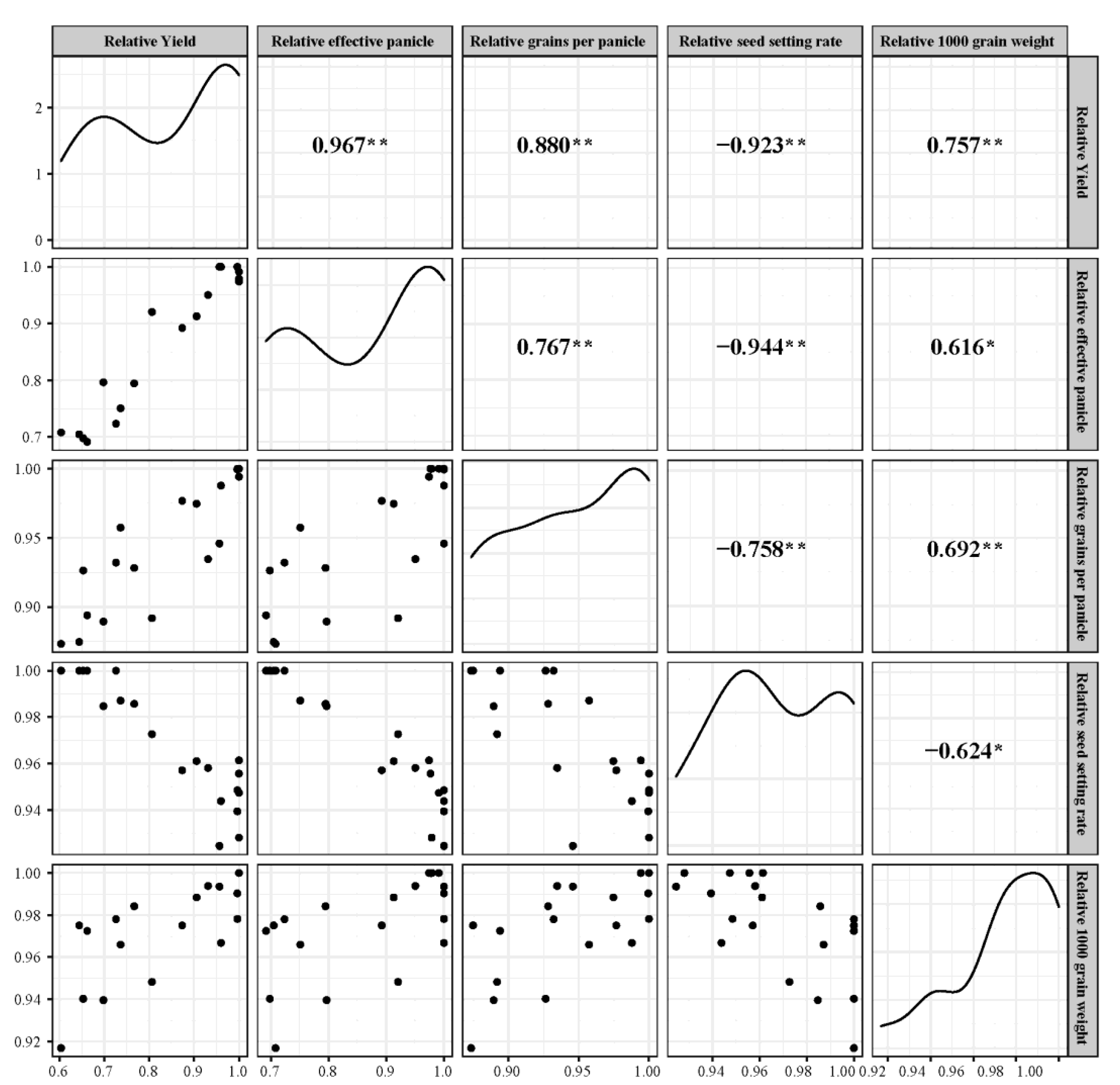
| Year | Organic Matter (g·kg−1) | Total N (g·kg−1) | Available P (mg·kg−1) | Available K (mg·kg−1) | pH |
|---|---|---|---|---|---|
| 2018 | 32.36 | 2.03 | 24.80 | 211.42 | 5.11 |
| 2019 | 30.89 | 1.77 | 25.97 | 245.52 | 5.54 |
| Grouping Factor | Variation Source | Sum of Squares | df | Mean Square | F-Value | p-Value |
|---|---|---|---|---|---|---|
| Nitrogen rate | Between groups | 1.983 | 4 | 0.496 | 21.197 | 0 |
| Within groups | 2.222 | 95 | 0.023 | |||
| Total | 4.206 | 99 | ||||
| Variety | Between groups | 0.001 | 1 | 0.001 | 0.026 | 0.872 |
| Within groups | 4.204 | 98 | 0.043 | |||
| Total | 4.206 | 99 | ||||
| Year | Between groups | 0.263 | 1 | 0.263 | 6.536 | 0.120 |
| Within groups | 3.943 | 98 | 0.040 | |||
| Total | 4.206 | 99 |
| Growth Stage | Yield Components | Equation | N Nutrition Index (NNILAI) Threshold | Error Value (Compared to the RY Threshold) | R2 |
|---|---|---|---|---|---|
| 15 DAT (active tillering) | Relative effective panicle | y = 1.290x − 0.272 | 0.971 | 0.000 | 0.880 ** |
| Relative grains per panicle | y = 0.450x + 0.552 | 0.975 | 0.004 | 0.683 ** | |
| Relative seed setting rate | y = −0.238x + 1.182 | 0.993 | 0.022 | 0.811 ** | |
| Relative 1000 grain weight | y = 0.216x + 0.788 | 0.940 | −0.031 | 0.526 ** | |
| 30DAT (mid-tillering) | Relative effective panicle | y = 1.106x − 0.239 | 1.106 | 0.000 | 0.875 ** |
| Relative grains per panicle | y = 0.405x + 0.545 | 1.101 | −0.005 | 0.655 ** | |
| Relative seed setting rate | y = −0.220x + 1.190 | 1.120 | 0.014 | 0.808 ** | |
| Relative 1000 grain weight | y = 0.154x + 0.823 | 1.092 | −0.014 | 0.320 ** | |
| 45DAT (stem elongation) | Relative effective panicle | y = 0.691x + 0.206 | 1.131 | 0.015 | 0.793 ** |
| Relative grains per panicle | y = 0.268x + 0.694 | 1.108 | −0.008 | 0.764 ** | |
| Relative seed setting rate | y = −0.136x + 1.100 | 1.117 | 0.001 | 0.827 ** | |
| Relative 1000 grain weight | y = 0.119x + 0.864 | 1.066 | −0.050 | 0.506 ** | |
| 60DAT (panicle initiation) | Relative effective panicle | y = 0.523x + 0.432 | 1.067 | 0.014 | 0.766 ** |
| Relative grains per panicle | y = 0.181x + 0.798 | 1.062 | 0.009 | 0.673 ** | |
| Relative seed setting rate | y = −0.103x + 1.055 | 1.053 | 0.000 | 0.900 ** | |
| Relative 1000 grain weight | y = 0.087x + 0.906 | 1.066 | 0.013 | 0.516 ** | |
| 75DAT (heading) | Relative effective panicle | y = 0.509x + 0.495 | 0.960 | 0.008 | 0.776 ** |
| Relative grains per panicle | y = 0.194x + 0.808 | 0.943 | −0.009 | 0.722 ** | |
| Relative seed setting rate | y = −0.098x + 1.042 | 0.952 | 0.000 | 0.779 ** | |
| Relative 1000 grain weight | y = 0.084x + 0.917 | 0.890 | −0.062 | 0.452 ** |
| Growth Stage | Yield Components | Equation | N Nutrition Index (NNILAI) Threshold | Error Value (Compared to the RY Threshold) | R2 |
|---|---|---|---|---|---|
| 15 DAT(active tillering) | Relative effective panicle | y = 1.060x − 0.049 | 0.981 | −0.049 | 0.785 ** |
| Relative grains per panicle | y = 0.407x + 0.600 | 0.977 | −0.053 | 0.736 ** | |
| Relative seed setting rate | y = −0.200x + 1.143 | 0.997 | −0.033 | 0.744 ** | |
| Relative 1000 grain weight | y = 0.204x + 0.803 | 0.925 | −0.105 | 0.620 ** | |
| 30DAT(mid-tillering) | Relative effective panicle | y = 1.213x − 0.164 | 0.954 | 0.014 | 0.736 ** |
| Relative grains per panicle | y = 0.435x + 0.580 | 0.945 | 0.005 | 0.736 ** | |
| Relative seed setting rate | y = −0.241x + 1.175 | 0.943 | 0.003 | 0.686 ** | |
| Relative 1000 grain weight | y = 0.205x + 0.804 | 0.913 | −0.027 | 0.542 ** | |
| 45DAT(stem elongation) | Relative effective panicle | y = 0.596x + 0.284 | 1.150 | 0.060 | 0.672 ** |
| Relative grains per panicle | y = 0.236x + 0.720 | 1.129 | 0.039 | 0.742 ** | |
| Relative seed setting rate | y = −0.111x + 1.079 | 1.137 | 0.047 | 0.666 ** | |
| Relative 1000 grain weight | y = 0.111x + 0.870 | 1.096 | 0.006 | 0.570 ** | |
| 60DAT(panicle initiation) | Relative effective panicle | y = 0.493x + 0.406 | 1.070 | 0.000 | 0.804 ** |
| Relative grains per panicle | y = 0.205x + 0.760 | 1.060 | −0.010 | 0.713 ** | |
| Relative seed setting rate | y = −0.095x + 1.059 | 1.064 | −0.006 | 0.731 ** | |
| Relative 1000 grain weight | y = 0.098x + 0.887 | 1.100 | 0.030 | 0.390 ** | |
| 75DAT(heading) | Relative effective panicle | y = 0.574x + 0.372 | 1.035 | −0.015 | 0.862 ** |
| Relative grains per panicle | y = 0.214x + 0.765 | 1.056 | 0.006 | 0.706 ** | |
| Relative seed setting rate | y = −0.106x + 1.062 | 1.050 | 0.000 | 0.910 ** | |
| Relative 1000 grain weight | y = 0.086x + 0.903 | 1.024 | −0.026 | 0.525 ** |
Publisher’s Note: MDPI stays neutral with regard to jurisdictional claims in published maps and institutional affiliations. |
© 2022 by the authors. Licensee MDPI, Basel, Switzerland. This article is an open access article distributed under the terms and conditions of the Creative Commons Attribution (CC BY) license (https://creativecommons.org/licenses/by/4.0/).
Share and Cite
Xu, H.; He, H.; Yang, K.; Ren, H.; Zhu, T.; Ke, J.; You, C.; Guo, S.; Wu, L. Application of the Nitrogen Nutrition Index to Estimate the Yield of Indica Hybrid Rice Grown from Machine-Transplanted Bowl Seedlings. Agronomy 2022, 12, 742. https://doi.org/10.3390/agronomy12030742
Xu H, He H, Yang K, Ren H, Zhu T, Ke J, You C, Guo S, Wu L. Application of the Nitrogen Nutrition Index to Estimate the Yield of Indica Hybrid Rice Grown from Machine-Transplanted Bowl Seedlings. Agronomy. 2022; 12(3):742. https://doi.org/10.3390/agronomy12030742
Chicago/Turabian StyleXu, Haocong, Haibing He, Kun Yang, Haojie Ren, Tiezhong Zhu, Jian Ke, Cuicui You, Shuangshuang Guo, and Liquan Wu. 2022. "Application of the Nitrogen Nutrition Index to Estimate the Yield of Indica Hybrid Rice Grown from Machine-Transplanted Bowl Seedlings" Agronomy 12, no. 3: 742. https://doi.org/10.3390/agronomy12030742
APA StyleXu, H., He, H., Yang, K., Ren, H., Zhu, T., Ke, J., You, C., Guo, S., & Wu, L. (2022). Application of the Nitrogen Nutrition Index to Estimate the Yield of Indica Hybrid Rice Grown from Machine-Transplanted Bowl Seedlings. Agronomy, 12(3), 742. https://doi.org/10.3390/agronomy12030742






